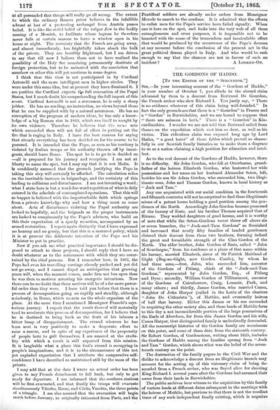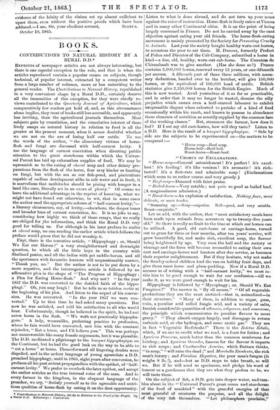THE CORDONS OF IIADDO.
[To TAR EDITOR OF TAR SFECTATOR.1 SIR, —In your interesting account of the " Gordons of Haddo," in your number of October 7, you allude to the absurd claim advanced by them to a descent from Bertrand De Gourdon, the French archer who slew Richard I. You justly say, " There is no evidence whatever of this claim being well-founded." In fact the only grounds are that there is a " Gourdon" in France and a " Gordon" in Berwickshire, and we are bound to suppose that " there are salmons in both." There is a " Gourdon" in Kin- cardineshire. I wonder we are not told that Bertrand sailed from thence on the expedition which cost him so dear, as well as his victim. This ridiculous claim was exposed long ago by Lord Hailes, " a good hater" of those fables which prevail so shame- fully in our Scottish family histories as to make them a disgrace to us as a nation claiming a high position for education and intel- lect.
As to the real descent of the Gordons of Haddo, however, there is no difficulty. Sir John Gordon, who fell at Otterburne, grand- father of the heiress Elizabeth Gordon, who bestowed her wide possessions and her name on her husband Alexander Seton, left, besides his son Sir Adam Gordon, who succeeded him, two illegi- timate sons, John and Thomas Gordon, known in local history as " Jock and Tam."
Any one acquainted with our social condition in the fourteenth and fifteenth centuries will not be surprised to find these illegitimate scions of a potent house holding a good position among the gen- tlemen of the North. Accordingly John Gordon became possessed of the barony of Essie, and his brother Thomas acquired that of Rivane. They wedded daughters of good houses, and it is worthy of note that while the Seton-Gordons never threw off above six or seven branches, the " Jock-and-Tam Gordons" so flourished and increased that nearly fifty families of landed gentlemen claimed their descent from these two brothers, forming indeed the great and formidable strength of the Clan Gordon of the North. The elder brother, John Gordon of Essie, called " John of Scurdargue," from his residence at a place of that name within his barony, married Elizabeth, sister of Sir Patrick Maitland of Gight (Bog-au-Gight, now Gordon .Castle), by whom he had three sons,—first, John, who succeeded him, ancestor of the Gordons of Pitlarg, chiefs of the " Jock-and-Tam Gordons," represented by John Gordon, Esq., of Pitlarg and Dyce ; secondly, William Gordon of Tillitarmont, ancestor of the Gordon of Cairnborrow, Craig, Lesmoir, Park, and many others ; and thirdly, James Gordon, who married Canea, daughter of John Harper (called in the Latin of the charters " John De Citharista "), of Methlic, and eventually heiress of half that barony. Either this James or his son succeeded in acquiring the other moiety also, and these lands of Methlic form to this day a not inconsiderable portion of the large possessions of the Earls of Aberdeen, for from this James Gordon and his wife, Canes Harper, that distinguished family is undoubtedly descended. All the manuscript histories of the Gordon family are unanimous on this point, and some of these date from the sixteenth century. Sir Robert Gordon, of Gordonstoun, writing about 1625, includes the Gordons of Haddo among the families sprung from " Jock and Tam" Gordon, which shows what was the belief of the seven- teenth century on the point.
The destruction of the family papers in the Civil War and the dislike to acknowledge a descent from an illegitimate branch may account for the setting up of this visionary claim of being de- scended from a French archer, who was flayed alive for shooting King Richard L several years after the Gordons had assumed their name from their lands in Berwickshire.
The public archives bear witness to the acquisition by this family of various lands at different dates subsequent to the marriage with the heiress of Methlic, but previous to that there is not the smallest trace of any such independent family existing, which is negative evidence of the falsity of the claims set up almost sufficient to upset them, even without the positive proofs which have been
adduced.—I am, Sir, your obedient servant, SCOTUS. October 10, 1865.































 Previous page
Previous page